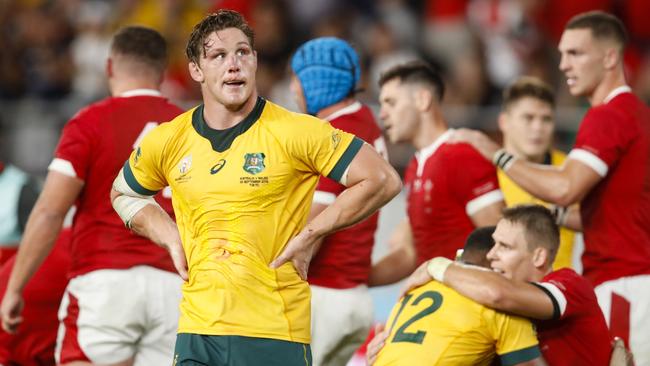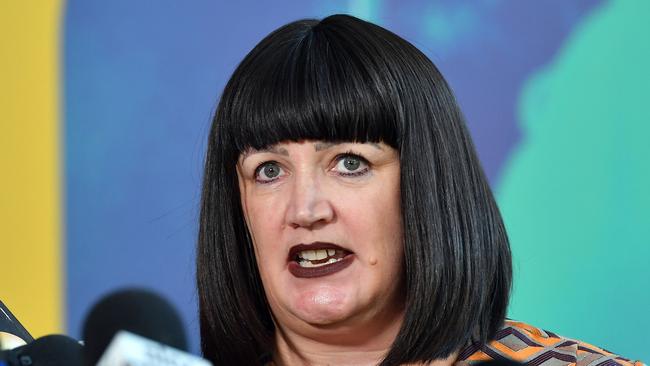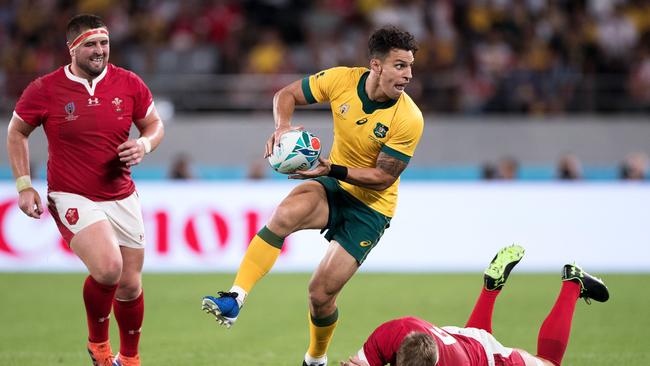Rugby Australia’s books reveal the $500m blackhole that crippled the game
Rugby Australia’s disastrous financial position can finally be revealed with the organisation blowing $500 million over the past four years.

Rugby
Don't miss out on the headlines from Rugby. Followed categories will be added to My News.
Rugby Australia’s disastrous financial position can be revealed with the organisation blowing $500m over the past four years and staring at liabilities well in excess of $20m.
Rugby Australia was spending $320,000 a day last year to run the game and could be heading down the path of insolvency.
The Australian has obtained key details from the still unaudited 2019 annual report that confirm the organisation has total liabilities in excess of $45m of which there is $20m owed to creditors — including $7.04m in a currency hedge fund to HSBC at the end of December 31.
It has been suggested that KPMG is further away from providing the audit report for the 2019 results and where they end up is understood to be entirely reliant on a $17m loan from World Rugby. The World Rugby rescue package is expected to drop this week.
Stream over 50 sports on-demand with KAYO SPORTS on your TV, computer, mobile or tablet. Just $25/month, no lock-in contract. Get your 14-day free trial and start streaming instantly >

Rugby sources say that sum is not enough to clear all the creditors and other liabilities that might emerge, with losses resulting from the COVID-19 crisis this year just adding to the problem.
The 2019 annual report shows the organisation spent nearly $120m last year, including $19m on corporate expenses. Corporate expenses typically include marketing, human resources, legal costs and other sources of head office spending.
The Wallabies slipped to No 7 in the world, crowds and TV viewers have gone down, despite millions being poured into marketing, high performance and teams.
The 2019 report details its biggest operating expenditure is on Super Rugby which tops $30.9m. ‘Super Rugby team costs’ total $6.3m and ‘Super Rugby and High Performance funding’ hit $24.6m. Player payments and RUPA costs were $20.5m.
There was a $19m spend on ‘corporate’ operating expenditure but last year only $4.3m was spent on ‘Community Rugby’.
Wallabies team costs were $9.6m in a World Cup year while National Sevens Teams costs were $5.3m.

There are concerns the game is heading for insolvency as it struggles under the weight of COVID-19 with no start date for a competition, no assets and no broadcast deal for 2021.
The annual report shows RA had $12m in cash equivalents on the balance sheet as of December 31. It is unknown how much of that is left four months later, or the actual value of the other assets on the balance sheet, many of which are understood to be ‘intangibles’.
Incoming Wallabies coach David Rennie is expected to start in July and his wage is close to $1m. Former CEO Raelene Castle is also expected to have received a payout including a $119,000 bonus approved by then chairman Cameron Clyne due to meeting some KPIs in 2019.
There are also other ‘financial liabilities’ and ‘deferred revenue’ amounts that are substantial and add more mystery to the overall financial position.
On the 2019 balance sheet there is $11m owed to creditors, plus $7m for the currency hedge loss (yet to crystallise) and $2.5m for employees. There is also deferred revenue of $14m plus lease commitments of $11m. The Australian has learnt of a number of creditors waiting to be paid including Herbert Smith Freehills, who were owed $800,000 in 2019 for legal work including on the Israel Folau case last year and are still due more payments expected to tip well over the $1m mark.

The game is staring at a financial abyss and there is huge work for the incoming chief executive. A recruitment firm is expected to be paid a six-figure sum to headhunt the next CEO while the incoming chairman is most likely to be Hamish McLennan.
The RA boardroom descended into chaos a week ago after Peter Wiggs was fleetingly appointed RA chair, but then demanded that AOC boss Matt Carroll be immediately appointed as his CEO.
Wiggs made the demand aware that RA was in serious financial trouble having done a deep dive into the books and believed the organisation had “no time to waste”.
The majority of the board turned down Wiggs’s ‘captain’s pick’ with board members Hayden Rorke, John Wilson, Pip Marlow and Dan Herbert insisting due process be followed.
Wiggs was said to be concerned about RA’s staffing levels as well as describing the organisation as the “worst-run business” he had ever seen.
At the start of the year Rugby Australia employed more than 207 staff. Castle notably increased the size of the media department by 33 per cent. Seventy-five per cent of the RA workforce has been stood down because of COVID-19. Eight years ago, the Australian Rugby Union employed 90 front office staff. In 2003 there were 35 front office staff the same year the Wallabies made the Rugby World Cup final and benefited from a $44m windfall from hosting the tournament.

Players aware the future of the game in Australia is in peril are considering their options, understanding they won’t be paid out and players are already fielding offers from overseas clubs. It is understood some have committed to leaving, even with two to three years left on their contracts.
The game is without a broadcast deal after Castle walked away from Fox Sports (owned by News Corp, publisher of The Australian) late last year rejecting a $US25 million-a-year offer for 2021-25. Castle for some time maintained she was close to a deal with Optus. Optus last week confirmed it was never seriously in the running for RA’s TV rights, international soccer being its priority.
The worrying state of RA places more pressure on longstanding board members, including interim chair Paul McLean who has served on the board for the past eight years. Marlow, who joined the board in 2016, made it clear last March she has “no intention to step down”.
Both where there when then CEO Bill Pulver announced his strategic plan in April 2016 on the back of a record $285m broadcast deal. Pulver outlined a strategic plan that outlined key goals included making the Wallabies No 1 in the world and set the goal of winning the 2019 Rugby World Cup, The Rugby Championship and Bledisloe Cup.
Another plan was for the “growth of a future fund to $10 million by 2020”. That has not happened.
Originally published as Rugby Australia’s books reveal the $500m blackhole that crippled the game

